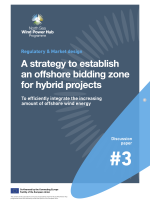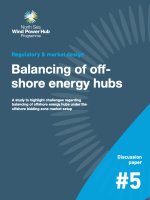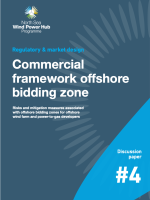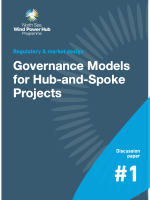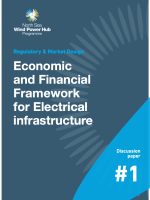Discussion paper: A strategy to establish an offshore bidding zone for hybrid projects
To efficiently integrate the increasing amount of offshore wind energy
Why read this report
Early clarity on the market setup is crucial for the investment decisions of project developers of offshore wind farms. This paper discusses the pathway in current EU regulation to establish an offshore bidding zone for hybrid projects. The analysis provided in this document aims to empower policymakers in their decision-making by facilitating a balanced and structured discussion. In order to provide a deeper understanding of the current regulation on the (re)configuration of bidding zones, a comprehensive analysis in the relevant EU regulation was performed. Furthermore, an alternative approach is proposed that allows TSO to identify long-term structural congestion without following the cumbersome bidding zone review process. Finally, the paper points at additional research required to further clarify the operability of the established offshore bidding zones.
Highlights
In case policy-makers aspire to integrate the Offshore Wind Farms (OWFs) and hub-and-spoke projects using an Offshore Bidding Zone setup, a substantial part of achieving this implies a sound methodology on the implementation of that relevant market setup.
The bidding zone review process seems not to be compatible (yet) with the development of hybrid projects under an offshore bidding zone setup.
An alternative approach, which is partly based on the already existing procedure described in Electricity Regulation, allows a TSO to identify long-term, structural congestion with a congestion report which is expected to take place within a time span of 9 – 18 months.
Executive summary
The increasing demand for renewable energy has driven ambitious goals for offshore wind power in Europe. Meeting this demand requires innovative solutions and a new, novel approach. The North Sea Wind Power Hub (NSWPH) is a consortium formed by TenneT Netherlands, TenneT Germany, Energinet and Gasunie to develop the energy infrastructure for integrating large-scale offshore wind from the North Sea into the European energy system. This paper discusses the pathway in current EU regulation to establish an offshore bidding zone market setup for offshore hybrid projects. Early clarity on the market setup is crucial for the investment decisions of project developers of offshore wind farms.
In case policy-makers aspire to integrate the Offshore Wind Farms (OWFs) and hub-and-spoke projects using an Offshore Bidding Zone setup, a substantial part of achieving this implies a sound methodology on the implementation of that relevant market setup. The EC has stated that “for the establishment of a new bidding zone, two pieces of legislation are relevant: the Electricity Regulation (EU) 943/2019 and the Guideline on Capacity Allocation and Congestion Management 1222/2015 (CACM Guideline)". Both pieces of legislation refer to the bidding zone review (BZR) methodology: a methodology that was once developed for an onshore bidding zone split, but for which it is uncertain if and how well it fits to a to-be-developed hybrid project.
In order to provide a deeper understanding of the current regulation on the (re)configuration of bidding zones, a comprehensive analysis in the relevant articles of the Electricity Regulation and CACM Guideline was performed. This analyses identified three main barriers when it comes to the establishment of an offshore bidding zone for hybrid projects:
- The bidding zone review process seems not to be compatible with the development of offshore hybrid projects under an Offshore Bidding Zone (OBZ) | The review methodology only includes assets that will be operational within three years. This makes it impossible to establish an OBZ and provide clarity to OWF developers before wind farm tendering. Wind farm tendering for a hub-and-spoke project is expected to take place about 5-7 years before go-live.
- The BZR is a lengthy and cumbersome process | The BZR may take up 20-34 months. The consultation rounds in the review methodology, although important, might slow down the final decision on the bidding zone configuration significantly. Furthermore, there is no guarantee that the outcome of the BZR will result in the establishment of a new OBZ. This might result in a significant increase in investment risks for hub-and-spoke stakeholders. Furthermore, it is currently unclear which stakeholders need to be involved in the different steps of a BZR.
- The BZR seems to be mainly focused on existing onshore bidding zones | The BZR review assesses whether the existing configuration of the existing bidding zones is optimal and can be improved. As a result, various steps that are of no relevance to the creation of an (new) OBZ are included in the technical report and review process.
